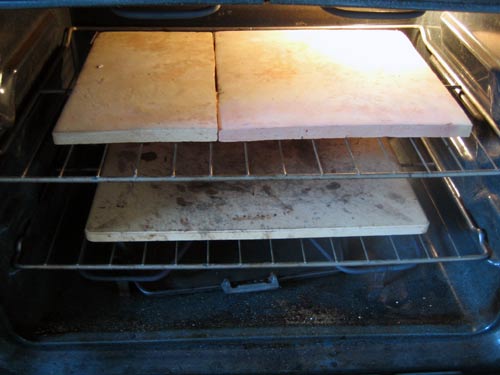I've finally come around on baking stones.
Early on, when I first started this site, I really didn't see the value of baking stones. They seemed to give a little extra pop to my loaves, but the difference seemed inconsequential.
I think I was doing a couple of things wrong. For one, I wasn't preheating my baking stone for long, and I was only heating it to my final baking temperature, typically no more than 400 degrees (see lesson one to see what I am talking about). Only preheating your baking stone for 15 or 20 minutes and only to 375 degrees is not enough to make much of a difference.
I also was initially using cheap, thin baking stones that didn't retain much heat. To really see the difference you need something more substantial.
So here is what you should do: get a substantial baking stone. You can buy one relatively inexpensively, or you can making one out of bricks or unglazed quarry tiles, which are extremely inexpensive and can be found at any home improvement shop. Place the stone in your oven at least an hour before baking and turn the temperature WAY up to 500 or 550 degrees, whatever is the maximum temperature your oven can safely go. Let the stone get EXTREMELY hot before placing your bread on it. If you do this you'll get much better oven spring and really notice the difference between bread baked on a baking sheet and bread baked on a stone.
I've been so happy with the results of my baking stone that I am currently experimenting with using a stone both above and below my loaves, to see if even more radiant heat will increase the spring.

No verdict yet.
Lesson Five, Number 2: Use a Baking Stone
- Log in or register to post comments
- Printer-friendly version


Comments
I've found the best way to get bread onto a preheated stone is to use a pizza peel. I picked one up at Bed Bath and Beyond for about $10--though I'm sure it's available elsewhere too. You'll need to put some flour or corn meal on the peel to ensure the bread doesn't stick, but you're on your way after that.
http://www.bedbathandbeyond.com/product.asp?order_num=-1&SKU=14457607
This one is more expensive, but you'll get the idea.
I bought an 18x18 inch travertine tile at Home Depot for under $7. It makes a great baking stone.
I bake my dough on parchment paper. It's easy to slide the paper on and off the stone.
by using more than one stone, you're increasing the thermal mass of the oven thereby shortening the recovery time of bringing the oven back to temp.
I use parchment sheets too when loading the oven - is there any appreciable difference between baking with the parchment on the stone versus baking directly on the stone?
Philip